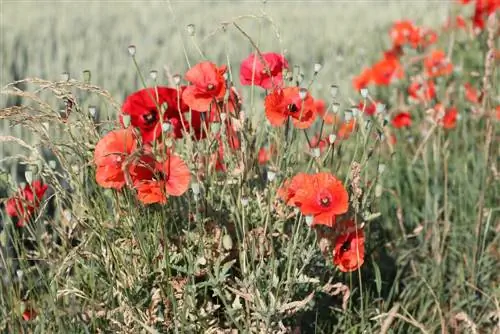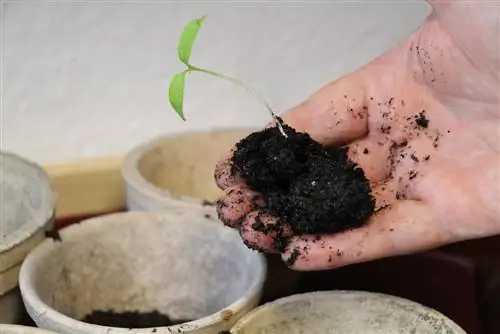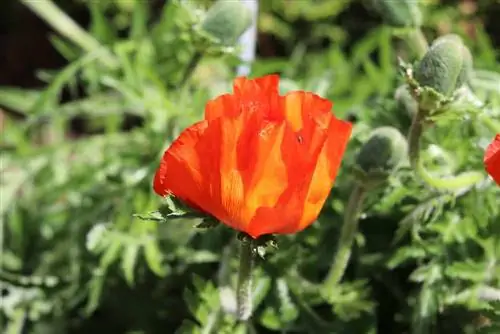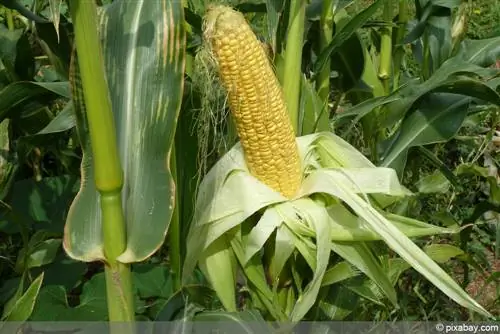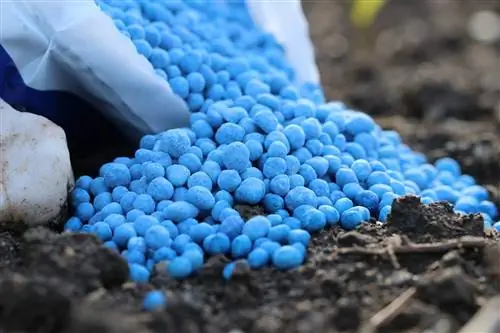- Author admin [email protected].
- Public 2023-12-17 03:39.
- Last modified 2025-06-01 06:48.
Common poppy is a deciduous plant that grows as one to two years. In the garden it is cultivated for one growing season. With a height of between 20 and 90 centimeters, the plant is suitable for beds, wildflower meadows and perennial borders. It develops a sparsely branched stem and impresses with its bright red petals. Caring for this native species is uncomplicated because Papaver rhoeas is undemanding.
Profile - Corn Poppy
- botanical: Papaver rhoeas
- Family: Poppy family (Papaveraceae)
- Flowering period from May to September
- natural habitats form fields, rubble dumps, roadsides and embankments
- typical ruderal plant that requires open ground
- Garden shapes are available in different color variations or filled
- Plant produces milky sap
Location and substrate
Poppies are light germinators and prefer a growing location in direct sun where warm conditions prevail. The poppy plant does not tolerate shade. Since the petals usually fall off after just one day, a location protected from the wind is recommended. This means the flowers last longer. Papaver rhoeas has hardly any demands on the soil. The plant thrives optimally on a dry and moderately nutrient-rich substrate. A high sand content ensures a loose structure so that water can seep through easily. The poppy grows optimally in such locations:
- sandy-loamy soil
- gravelly-loamy substrate
- slightly calcareous, pH value between 5.5 and 8.0
Watering and fertilizing
Common poppy needs moderate water once the seedlings have grown into magnificent plants. A regular watering routine is sufficient. Water the flowering plants during extended dry periods in summer. The plant survives dry spells better than waterlogging in the substrate.
Potted plants need regular water because the substrate in the pot dries out quickly. Daily watering supports he althy growth. Regular fertilization is not necessary. It is enough to enrich the soil with basic fertilization before sowing. This increases the flowering potential. Use fertilizer sparingly, otherwise the plants will shoot up and unstable stems will break easily.
Cutting
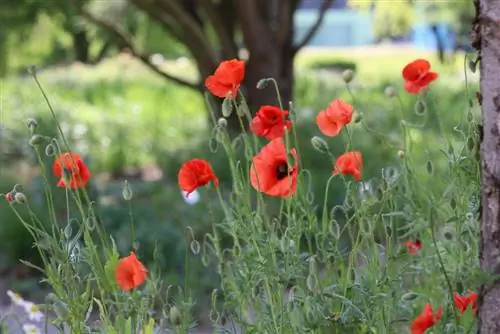
The care turns out to be uncomplicated. Cutting measures are not necessary. By cutting off wilted inflorescences, you prevent them from spreading too much throughout the garden and preventing new growth the following year. Corn poppies are not perennial and self-sow. For potted plants, it is recommended to regularly remove dead shoots. This encourages the plant to produce new flowers and extends the flowering period. If you want to harvest the seeds and process or grow them further, leave some flowers until the fruits are ripe.
Note:
Since Papaver rhoeas is cultivated as an annual, no overwintering is necessary. Allow bedding plants to wilt in the fall and store planters until next spring.
Propagate poppies
The poppy is propagated using seeds. You can buy these commercially or collect ripe fruit capsules. Established poppy meadows develop a productive seed population so that they self-sow in the fall and thrive successfully as cold germinators in the coming spring. If seed stocks are low, controlled sowing promises better success rates. Sow the seeds directly outdoors between April and June. Autumn sowing is also possible from September to October. Depending on the variety and flowering time, the exact sowing date may vary slightly.
Tip:
Sowing in autumn ensures early blooms in the coming year.
Soil preparation
Loosen the substrate thoroughly with a rake. Remove roots and weeds. Mix sand or gravel into the substrate. You do not necessarily have to enrich the soil with nutrients before planting, as the poppy grows successfully on a nutrient-poor substrate. If you want to mix in compost to improve flowering, you should apply it a few weeks before sowing or ideally in autumn. This allows microorganisms to decompose the substrate and optimally prepare the soil. Mix sand into the soil to create higher porosity.
Sowing
Since Papaver rhoeas develops very fine seeds, mix the seeds with a handful of fine sand before scattering and add the desired seeds of other wildflowers. With sand, the delicate grains can be distributed better by spreading the mixture widely. This way you don't have to thin out the seedlings later. In order for the seeds to germinate, sufficient irrigation is necessary. Use a very fine watering attachment to avoid washing away the seeds. Alternatively, we recommend a spray bottle that you use to spray the seeds daily. You will have the best chance of success if you pay attention to these aspects:
- sow continuously to extend the flowering period
- Light germinators: must not be covered with substrate after sowing
- Cold germinator: Seeds germinate at two to 13 degrees Celsius
- Germination time: six to ten days
Usage
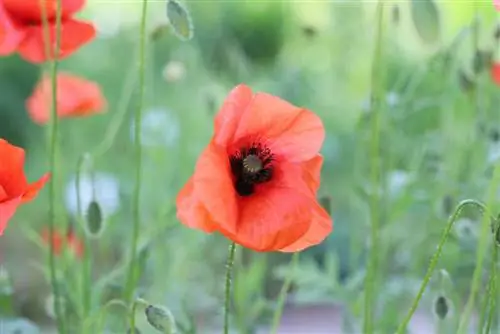
Corn poppies are ideal in small areas of 30 to 60 centimeters. If a wild character is desired, sow the seeds at will on the prepared area. Here the plants automatically develop a natural meadow. To create a bed-like structure, ensure a row spacing of 50 to 80 centimeters between the wildflower beds. Suitable plant neighbors are herbaceous plants with different flower colors that are reminiscent of wildflower meadows:
- Candytuft (Iberis umbellata)
- Jewelry basket (Cosmos bipinnatus)
- Virgin in the countryside (Nigella damascena)
- Columbine (Aquilegia vulgaris)
- Field delphinium (Consolida regalis)
Tip:
In the natural garden, native wild plants are on the planting list. The corn poppy harmonizes with cornflower, daisy and corn wheel.
Harvest time
Fruit ripening takes place from July to August. Poppies develop the typical seed capsules, the cover of which is reminiscent of a wavy roof. The depressions serve as a windbreak so that the capsule can effectively scatter its 2,000 to 5,000 black seeds. The poppy seed capsule dries up as the fruit develops, so that the pores open. In late summer the capsule fruits are completely dry and brown in color. You can harvest the fruits at any time during fruit ripening. Test beforehand by shaking gently whether the seeds have already detached from the walls. The longer you wait, the less seeds there will be in the fruit. Cut off the seed pods along with the stems. Shake the capsules over a container until all the seeds have trickled out. Store the seeds in a cool and dry place.
Diseases and pests
The poppy plant is rarely affected by plant diseases or leaf pests. If you grow the crop in a location that is too wet, powdery mildew can spread. Poppy plants are more often affected by poppy blight. This bacterial disease manifests itself as brown to blackish blooms or slimy spots. Control is usually unnecessary because the plant is not grown perennial.
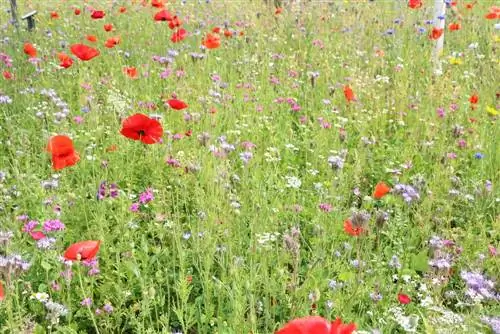
Dispose of affected specimens in the trash so that the bacteria do not infect the entire population. Avoid growing plants in this location for the next two years. Occasionally your poppies may become infested with aphids. Help against these plant sap-sucking pests:
- Sprays with nettle broth
- wetting with a soft soap solution
- Use of beneficial insects such as ladybirds and lacewings

